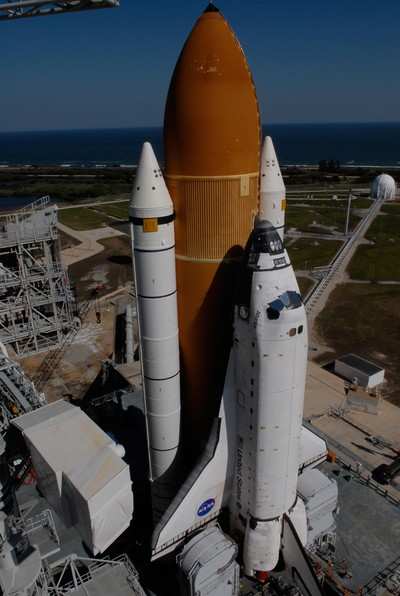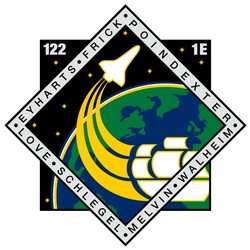But Weather Threatens Oft-Delayed Shuttle Flight
We're at less than two days and counting for first available
launch opportunity for the space shuttle Atlantis, on its
twice-delayed mission to the International Space Station. Liftoff
is scheduled for Thursday at 1445 EST, according to NASA.

Mission Management Team Chairman Leroy Cain said Atlantis and
its European-built Columbus laboratory look good for the mission.
"The team is in great shape and we're ready to move forward," Cain
said.
If only the Florida wintertime weather were so cooperative. The
current forecast pegs the chances of acceptable conditions for
launch at a mere 40 percent, with showers and thunderstorms
threatening to last into the weekend.
For the moment, at least, the launch is still a "go." Launch
director Doug Lyons told The Associated Press the countdown is
proceeding without issues, and "we're hoping it will stay that
way."
"We're all thinking that Thursday's the day regardless of what
the weather guy might tell you," he added.
Also keeping their fingers crossed are Mission Commander Steve
Frick and Pilot Alan Poindexter, who started the day Tuesday
practicing landing the shuttle in the Shuttle Training Aircraft --
a specially-outfitted Gulfstream II bizjet outfitted with a
combination of modifications to the exterior, and a complex suite
of computers, to make the transformation from everyday jet-handling
to that of a 110-ton falling brick -- er, orbiter.
 Meanwhile, the five mission
specialists for the flight are also spending full days with
checklists and practicing their flight tasks. They have simulators
at their disposal that let them rehearse the complex duties
required in orbit.
Meanwhile, the five mission
specialists for the flight are also spending full days with
checklists and practicing their flight tasks. They have simulators
at their disposal that let them rehearse the complex duties
required in orbit.
Astronaut Leland Melvin, for example, will operate the robot arm
on the International Space Station during the mission to move the
Columbus laboratory out of Atlantis' payload bay and attach it to
the station. So he can rehearse with a simulator in the Astronaut
Crew Quarters that is set up with the same kind of controllers he
will use on the station.
As the lead spacewalker on three EVAs, Rex Walheim goes into
space with a lot of checklists. One of the spacewalks will include
astronaut Stanley Love, who will also help Melvin with the space
station's robot arm.
Because the astronauts will be working with two long robot arms
during spacewalks in which two astronauts are outside the station,
each move is highly choreographed and carefully practiced. It
routinely takes months of rehearsal before the actual duties are
carried out in space.
The crew also includes European Space Agency astronauts Hans
Schlegel of Germany and Leopold Eyharts of France. Both have a list
of duties for activating the Columbus lab, which was made in Europe
and is ESA's primary contribution to the space station project.
Schlegel will conduct two spacewalks during the flight to
connect power and fluid lines between Columbus and the station.
Eyharts will become Europe's first long-duration station
resident. He will take the place of NASA astronaut Dan Tani.
 NTSB Final Report: Cessna 177B
NTSB Final Report: Cessna 177B ANN's Daily Aero-Term (05.08.25): Final Approach Fix
ANN's Daily Aero-Term (05.08.25): Final Approach Fix Aero-News: Quote of the Day (05.08.25)
Aero-News: Quote of the Day (05.08.25) ANN's Daily Aero-Term (05.09.25): Estimated (EST)
ANN's Daily Aero-Term (05.09.25): Estimated (EST) ANN's Daily Aero-Linx (05.09.25)
ANN's Daily Aero-Linx (05.09.25)




